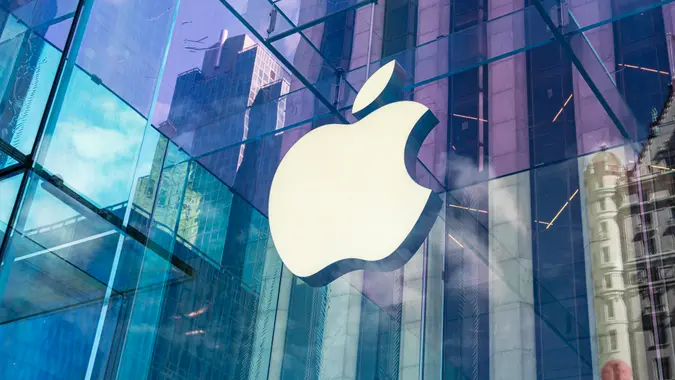Fidelity: 5 Reasons Why the Stock Market Is Volatile (And What You Can Do About Your Investments)

Commitment to Our Readers
GOBankingRates' editorial team is committed to bringing you unbiased reviews and information. We use data-driven methodologies to evaluate financial products and services - our reviews and ratings are not influenced by advertisers. You can read more about our editorial guidelines and our products and services review methodology.

20 Years
Helping You Live Richer

Reviewed
by Experts

Trusted by
Millions of Readers
There are plenty of ways to measure volatility in the stock market, but “the VIX” — the Chicago Board Option Exchange (CBOE) Volatility Index — has become standard “fear gauge” for the U.S. stock market. Even though it only measures the S&P 500 Index, it reflects the broader market predictions of volatility over the next 30 days and investors use it to evaluate market risk and sentiment.
The S&P 500 and the VIX have an inverse relationship. When the VIX’s price rises, the S&P 500’s price often falls. The VIX is up over the past 10 days, and nearly doubled between mid-February and mid-March, reflecting the current volatility of the U.S. stock market, President Donald Trump’s tariff announcement and a consumer sentiment that has soured over time.
According to Fidelity Investments, there are five factors contributing to the unpredictable state of the share market right now. However, as an investor, you have preventative options you can put into place at every unexpected turn of events.
Tariff Wars
As CNN reported, Wall Street has already lost trillions of dollars as a result of President Donald Trump’s tariff-based economic agenda, and traders and investors are anxiously pondering how Apr. 2, or “Liberation Day,” announcements will influence both U.S. and global markets things moving forward — especially since markets have plummeted to levels not seen since 2020 after Apr. 2.
Despite Trump’s attempts to free America from its reliance on foreign goods, it might be time for you to at least consider investing in non-U.S. funds and diversify your portfolio by adding international funds, via direct investment, foreign ordinaries, American depository receipts (ADRs) and exchange-traded funds (ETFs) heavy on international companies.
Inflation Concerns
When the annual inflation rate jumped to a 40-year high of 9.1% in June 2022, it heightened investor anxiety and weakened consumer sentiment, and forced the Fed to start its fight against inflation by raising benchmark interest rates. While rates have hovered around 2.5% to 3% over the past six months, it’s still higher than the central bank’s target and the prices of goods and services are still excessive.
Although Fidelity recommends investing in TIPS — Treasury Inflation-Protected Securities that adjust their principal value based on the Consumer Price Index (CPI) — there are plenty of other ways to fight inflation as an investor, including hedging with gold, diversifying your portfolio with bonds and looking into real estate ownership and Real Estate Investment Trusts (REITs).
Fear of Recession
For many economists, it was a minor miracle that the U.S. economy didn’t fall into a recession at some point in the past three years. Despite over a dozen key interest rate hikes by the Federal Reserve, the economy has been remarkably resilient, thanks to strong labor stats and steady consumer spending.
However, recession talk is heating up again, as unemployment rates and inflation continue to tick upward over the past year. Add in depressed consumer sentiment and spending, plus the tariff wild card, and you have the “warning lights of a weakening economy,” according to CBS MoneyWatch correspondent Kelly O’Grady.
Although there are stocks that have consistently performed well during the past five recessions — Walmart (WMT), J.M. Smucker (SJM) and Ball (BALL) are three, according to Investor’s Business Daily — if you’re only invested in S&P 500 stocks and a recession hits, expect some financial turmoil.
“Many U.S. investors have this misguided notion that the S&P 500 Index is the be-all and end-all of the stock market,” said Schwab’s chief global investment strategist, Jeffrey Kleintop. “But if you’re not investing abroad, you’re missing out on more than half the global market.”
Interest Rates and Government Spending
The pursuit of balanced budgets via managing interest rates and cutting spending is one of the primary strategies to boost long-term growth, both domestically and internationally.
Stateside, the Federal Reserve has been cautious in tackling lower interest rates until some progress has been made on inflation, and despite assurances that the Department of Government Efficiency has “saved tens of billions of dollars” since Trump took office in January, U.S. government spending was up during Trump’s first month, compared to the same period in 2024, per Reuters.
With rates and government spending still high, look to defensive sectors that should continue to receive funding (e.g.: infrastructure, defense, healthcare and utilities) and consider short-term bonds and CDs that offer safe yields.
Struggling Tech Stocks
Over the past two years, technology stocks have pushed the markets to unparalleled success, but Fidelity has reported that tech is the second-worst performing sector year to date. Tech stocks are still a strong buy due to their boom over the past few years and continued competitive corporate earnings.
However, if recent downturns worry you as an investor, you can play the market and try to pick affordable tech stocks that will grow, or you can expand the mix in your portfolio or exchange-traded funds (ETFs) across numerous sectors.
Editor’s note on political coverage: GOBankingRates is nonpartisan and strives to cover all aspects of the economy objectively and present balanced reports on politically focused finance stories. You can find more coverage of this topic on GOBankingRates.com.
More From GOBankingRates
 Written by
Written by  Edited by
Edited by 























